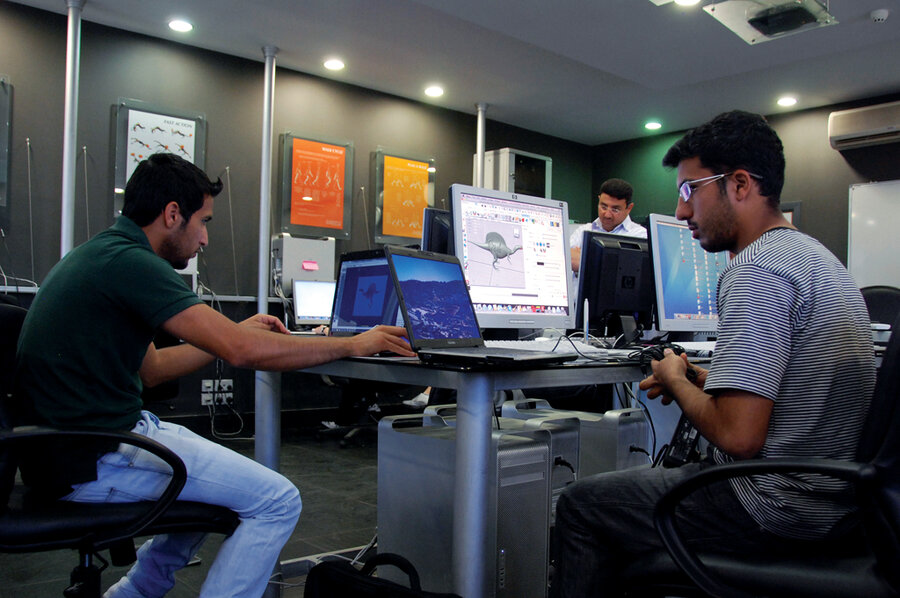Finding a better way to bridge the digital divide
| Amman, Jordan
This is the first in a two-part series on making the Web more worldwide. The second article is available here.
At a recent Internet culture conference at the Massachusetts Institute of Technology in Cambridge, a local ice-cream shop offered to make a custom flavor for the event. After some discussion, the organizers decided that it should be vanilla ice cream mixed with Nerds candies, "because the Internet is primarily white and nerdy," explains Chris Csikszentmihályi, who directs the MIT Center for Future Civic Media.
While a joke, the ice-cream flavor was also a serious commentary on the digital divide that has grown between those who created the Internet – mostly affluent, white, male programmers – and the billions of people around the globe with whom they share little in common.
There's a push among development specialists to provide more people with Internet connections and the assumption that these new Web citizens can then reap the same benefits as communities who've long been online.
This may not be the case, however. While few people dispute the value of getting the world online, many Internet experts say that current Web content has little relevance and thus little appeal to those whose lifestyle is worlds away from programmers in the United States and Europe. If the majority of the world is to use the Web for more than just a few basic functions, Internet developers must address this gap.
"What you end up with is an Internet that assumes a particular kind of user, one that resembles the authors," says Mr. Csikszentmihályi. "So, in a sense, almost everyone who uses the Internet has to sort of pass as a white, 20-something, urban-dwelling kind of person."
Even in the US, this has proved to be a problem. A new study at Northwestern University in Evanston, Ill., found that, among Americans, those from privileged backgrounds tend to have much higher skill levels and use the Web for more activities than those from less affluent families with equal Internet access.
"Just because people gain access doesn't mean that now they know how to use the Internet," says Eszter Hargittai, author of the report. "Even if we put a lot of effort into connecting more people – which is of course important – [the concern is that] even once people obtain access, we will continue to observe considerable variation in their skills and online behavior."
For those outside the US, crossing the digital divide may seem even more daunting. In the Middle East, since 2000, Internet use has grown faster than anywhere else in the world. Although there are more Arabs online every day and their language is the world's fifth most widely spoken, less than 1 percent of Web content is in Arabic. Within the region, Jordan has been one of the most active countries bridging the digital divide. Here the information technology (IT) sector enjoys strong support from King Abdullah II and makes up 12 percent of the nation's gross domestic product. According to StartupArabia, a website dedicated to tracking Arab tech companies, only the United Arab Emirates has surpassed Jordan in the number of start-ups.
"Jordan doesn't have resources. We don't have oil; we don't have any major mineral resources; the only thing we have is education," says Khamis Omar, dean of the IT department at the Princess Sumaya University for Technology in Amman, explaining the success of the IT industry in Jordan.
Despite these successes, Jordan is still on the far side of the perceived chasm. Only 54 percent of Jordanian homes have a personal computer and about 30 percent of people use the Internet. Of those who don't have computers, about half said they couldn't afford them while 40 percent said they didn't need them, according to a report by the Department of Statistics released to The Jordan Times last month.
In some regards, it may take decades for the Internet, like other technological revolutions, to take firm root outside its place of origin, says Steven Low, a computer science professor at the California Institute of Technology in Pasadena. "It takes time not only for the technology to mature, but also for [a different] society to learn how to use it and then adapt how you live or how you work to make the most use of it," he says. "That process has been going on in the developed world for the last several decades in terms of IT ... but it's only starting for the developing world."
In the meantime, Robert Fadel of the nonprofit One Laptop Per Child says one of the most important things is to continue making technology available to more people so they can find ways to make it applicable to their lives. In the past two years, OLPC has helped distribute 1.5 million laptops to children in 35 countries.
"Children, with the support of their community and their parents and teachers, will find it all out, they will discover it. We can help them out by giving them the freedom and the access to use such tools," says Mr. Fadel. He adds that worrying that people might not get the full benefit of the Internet because they don't know how to use it, is like worrying that people may not benefit from a library if no one explains how to use it.
Still, Ms. Hargittai says that, for real Internet equality, it will likely take more than simply putting the tools in people's hands. Organizations working to bridge the divide must "devote resources to offering support, and potentially having a center where people can go for support, offering informal classes or instruction for the community," she says. She adds that any classes would need to effectively target the necessary audience, as many people may not know how much more they have to learn.
This is the first in a two-part series on making the Web more worldwide. The second article is available here.





